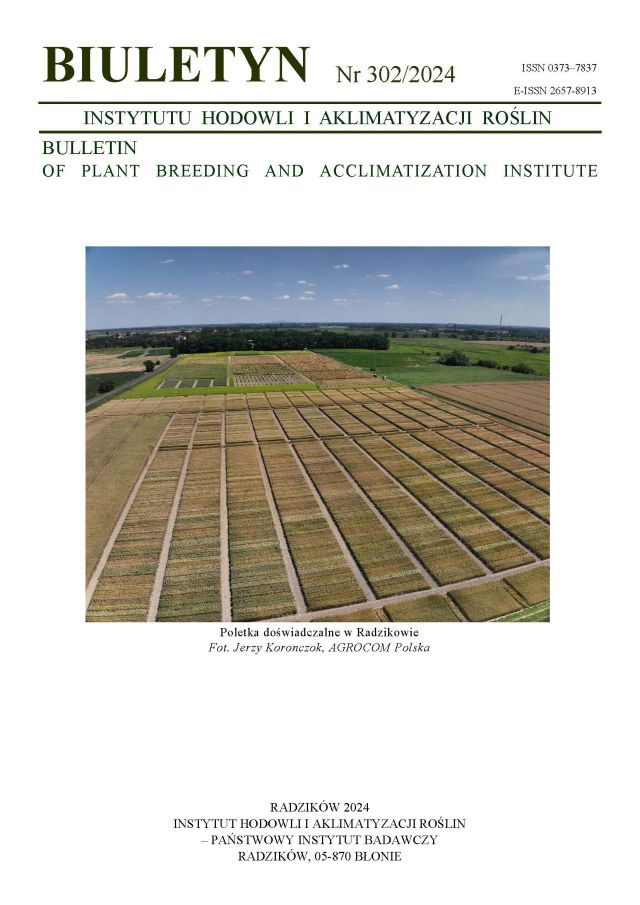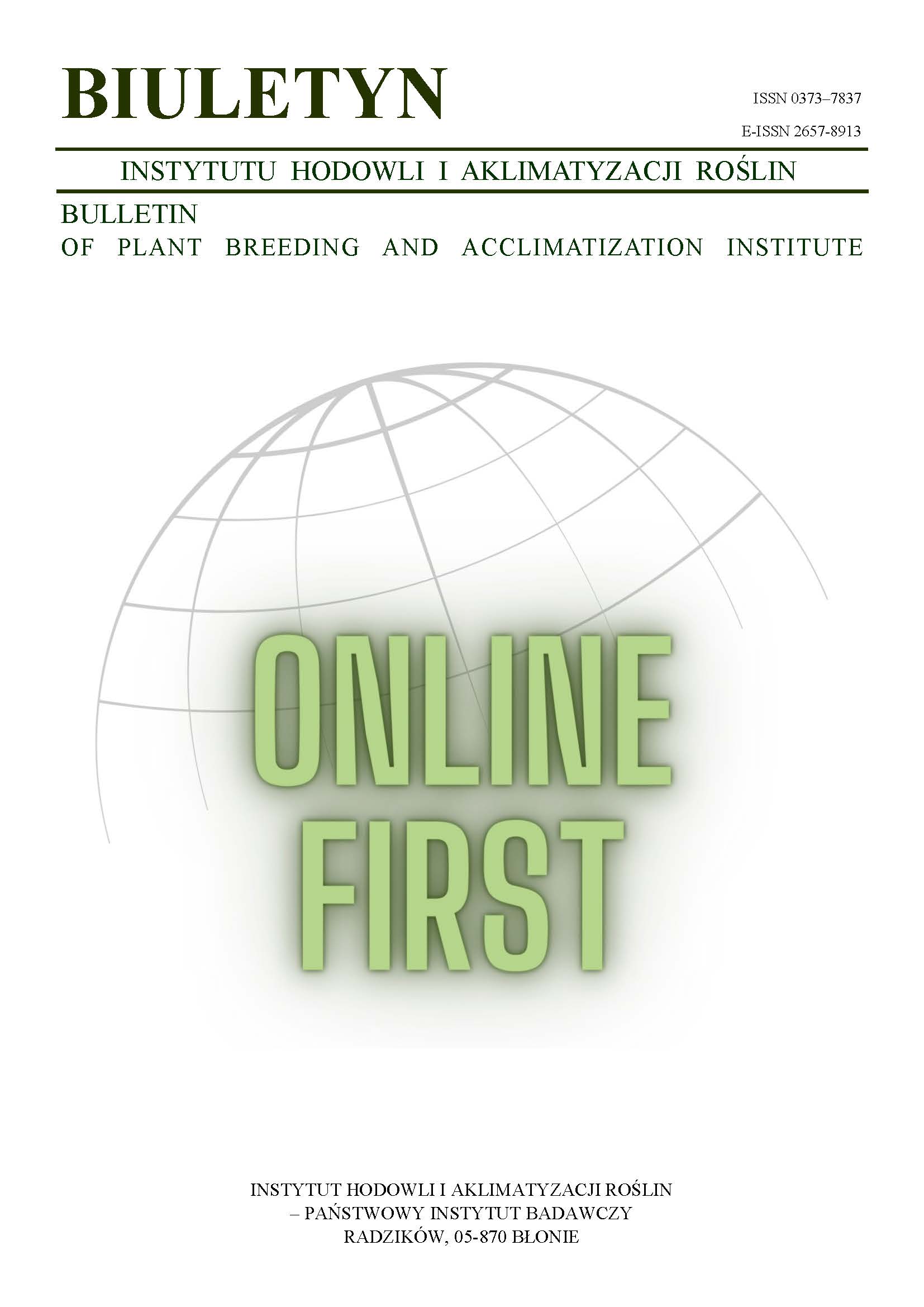Selection parameters in breeding on the new wheat cultivars in the aspect of functional food production
Wioletta Monika Dynkowska
wioletta.dynkowska@gmail.comInstytut Hodowli i Aklimatyzacji Roślin — Państwowy Instytut Badawczy, Radzików (Poland)
https://orcid.org/0000-0001-8563-7032
Małgorzata Renata Cyran
Instytut Hodowli i Aklimatyzacji Roślin — Państwowy Instytut Badawczy, Radzików (Poland)
https://orcid.org/0000-0003-0820-6962
Abstract
Wheat grain, a principal bread cereal in the world, represents a substantial source of dietary fiber and antioxidants in the modern human diet. A recent systematic increase in consumer attention paid to functional food, being an important element in preventing and treatment of civilization diseases, is observed in Poland. This points to a need for the breeding of new wheat cultivars recommended for functional food production.
Grains of 46 winter wheat lines were evaluated with respect to their water extract viscosity, total phenolics content and the amount and composition of dietary fiber. A small number of lines were characterized by high grain extract viscosity, a primary factor that controls, among others, a decrease in glucose and cholesterol levels after consumption of cereal-based products. The grain extract viscosity was positively correlated with soluble arabinoxylan content. However, in many cases, high extract viscosity genotypes had markedly lower content of these polysaccharides, indicating paramount importance of their structural characteristics for viscosity level. Especially significant is the length of polysaccharide chain (molecular weight) that was assessed indirectly as grain extract viscosity per unit mass of arabinoxylans. Amongst wheat lines studied, only two of them exhibited both high grain extract viscosity and high concentration of phenolic compounds.
Genotypes, combing high viscous potential with high antioxidant capacity as well as increased share of soluble dietary fiber polysaccharides, should represent the starting material for the breeding of new wheat cultivars designed for production of functional food.
Supporting Agencies
Keywords:
dietary fiber, dietary fiber arabinoxylans, grain extract viscosity, nonstarch polysaccharides, total phenolic components, winter wheatReferences
Boros, D., Marquardt, R. R., Słomiński, B. A., Guenter, W. 1993. Extract viscosity as an indirect assay for water-soluble pentosan content in rye. Cereal Chemistry, 70 (5): 575–580.
Google Scholar
Chen, M., Guo, L., Nsor-Atindana, J., H. Goff, D., Zhang, W., Mao, J., Zhong, F. 2020. The effect of viscous soluble dietary fiber on nutrient digestion and metabolic responses Ⅰ: In vitro digestion process. Food Hydrocolloids, 107: 105971. https://doi.org/10.1016/j.foodhyd.2020.105971
Google Scholar
Cook, S. I., Sellin, J. H. 1998. Review article: short chain fatty acids in health and disease. Alimentary Pharmacology & Therapeutics, 12 (6): 499–507. https://doi.org/10.1046/j.1365-2036.1998.00337.x
Google Scholar
Cummings, J. H., Pomare, E. W., Branch, H. W. J., Naylor, E., Macfarlane, G. T. 1987. Short chain fatty acids in human large intestine, portal, hepatic and venous blood. Gut, 28: 122–123. https://doi.org/10.1136/gut.28.10.1221.
Google Scholar
Cummings, J. H. 1984. Constipation, dietary fibre and the control of large bowel function. Postgraduate Medical Journal, 60: 811–819. https://doi.org/10.1136/pgmj.60.709.811
Google Scholar
Cyran, M. R., Dynkowska, W. M. 2014. Mode of endosperm and wholemeal arabinoxylans solubilisation during rye breadmaking: Genotypic diversity in the level, substitution degree and macromolecular characteristics. Food Chemistry, 145: 356–364. https://doi.org/10.1016/j.foodchem.2013.07.093
Google Scholar
Cyran, M. R., Dynkowska, W. M., Ceglińska, A., Bonikowski, R. 2021. Improving rye bread antioxidant capacity by bread-making methodology: Contribution of phosphate-buffered saline- and methanol-soluble phenolic phytochemicals with different molecular profiles. Journal of Cereal Science, 100 (5): 103262. https://doi.org/10.1016/j.jcs.2021.103262
Google Scholar
Cyran, M. R., Rakowska, M., Wasilewko, J., Buraczewska, L. 1995. Degradation of dietary fibre polysaccharides of rye in the intestinal tract of growing pigs used as a model animal for studying digestion in humans. Journal of Animal and Feed Sciences. 4 (3): 217–227. https://doi.org/10.22358/jafs/69795/1995
Google Scholar
Cyran, M. R., & Saulnier, L. (2012). Macromolecular structure of water-extractable arabinoxylans in endosperm and wholemeal rye breads as factor controlling their extract viscosities. Food Chemistry, 131(2), 667–676. https://doi.org/10.1016/j.foodchem.2011.09.054
Google Scholar
Cyran, M. R., Ceglińska, A. 2011. Genetic variation in the extract viscosity of rye (Secale cereale L.) bread made from endosperm and wholemeal flour: impact of high-molecular-weight arabinoxylan, starch and protein. Journal of the Science of Food and Agriculture, 91(3), 469–479. https://doi.org/10.1002/jsfa.4208
Google Scholar
Cyran, M. R., Ceglińska, A., Kolasińska, I. 2012. Depolymerization degree of water-extractable arabinoxylans in rye bread: characteristics of inbred lines used for breeding of bread cultivars. Journal of Agricultural and Food Chemistry, 60 (35): 8720–8730. https://doi.org/10.1021/jf301573v
Google Scholar
Dynkowska, W. M. 2019. Rye (Secale cereale L.) phenolic compounds as health-related factors. Plant Breeding and Seed Science, 79, 9–24. https://doi.org/10.37317/pbss-2019-0002
Google Scholar
Dynkowska, W. M. 2020. Rye (Secale cereale L .) arabinoxylans: molecular structure , physicochemicals properties and their resulting pro-health effects. Plant Breeding and Seed Science, 81, 13–32. https://doi.org/10.37317/pbss-2020-0002
Google Scholar
Dynkowska, W. M., Cyran, M. R., Ceglińska, A. 2015. Soluble and cell wall-bound phenolic acids and ferulic acid dehydrodimers in rye flour and five bread model systems: Insight into mechanisms of improved availability. Journal of the Science of Food and Agriculture, 95(5), 1103–1115. https://doi.org/10.1002/jsfa.7007
Google Scholar
Elia, M, Cummings, J.H. 2007. Physiological aspects of energy metabolism and gastrointestinal effects of carbohydrates. European Journal of Clinical Nutrition, 61 (12) Suppl 1: S40-74. https://doi.org/10.1038/sj.ejcn.1602938
Google Scholar
Englyst, H. N., Cummings, J. H. 1984. Simplified method for the measurement of total non-starch polysaccharides by gas-liquid chromatography of constituent sugars as alditol acetates. Analyst, 109 (7): 937–942. https://doi.org/10.1039/AN9840900937
Google Scholar
Fraś, A., Gołębiewska, K., Gołębiewski, D., Boros, D. 2018. Dietary fibre in cereal grains - a review. Plant Breeding and Seed Science, 77: 43–53. https://doi.org/10.37317/pbss-2018-0004
Google Scholar
Gammoh, S., Alu’datt, M. H., Alhamad, M. N., Rababah, T., Ereifej, K., Almajwal, A., Ammari. Z, Al. Khateeb, W., Hussein, N. M. 2017. Characterization of phenolic compounds extracted from wheat protein fractions using high-performance liquid chromatography/liquid chromatography mass spectrometry in relation to anti-allergenic, anti-oxidant, anti-hypertension, and anti-diabetic properties. International Journal of Food Properties, 20 (10): 2383–2395. https://doi.org/10.1080/10942912.2016.1238832
Google Scholar
Henningsson, A., Bjorck, I., Nyman, M. 2001. Short-chain fatty acid formation at fermentation of indigestible carbohydrates. Scandinavian Journal of Nutrition, 45: 165–168. https://doi.org/10.3402/fnr.v45i0.1801
Google Scholar
Hernández, L., Afonso, D., Rodríguez, E. M., Díaz, C. 2011. Phenolic compounds in wheat grain cultivars. Plant Foods for Human Nutrition, 66 (4): 408–415. https://doi.org/10.1007/s11130-011-0261-1
Google Scholar
Hsu, J.-C., Penner, M. H. 1989. Influence of cellulose structure on its digestibility in the rat. The Journal of Nutrition, 119 (6): 872–878. https://doi.org/10.1093/jn/119.6.872
Google Scholar
Ikegami, S., Tsuchihashi, N., Nagayama, S., Harada, H., Nishide, E., Innami, S. 1983. Effect of indigestible polysaccharides on function of digestion and absorption in rats. Japan Society of Nutrition and Food Science, 36 (3): 163–168.
Google Scholar
Izydorczyk, M. S., Biliaderis, C. G., Bushuk, W. 1991a. Comparison of the structure and composition of water-soluble pentosans from different wheat varieties. Cereal Chemistry (USA), 68 (2): 139–144.
Google Scholar
Izydorczyk, M. S., Biliaderis, C. G., Bushuk, W. 1991b. Physical properties of water-soluble pentosans from different wheat varieties’. Cereal Chemistry, 68 (2): 145–150.
Google Scholar
Izydorczyk, M. S., Biliaderis, C. G. 1994. Studies on the structure of wheat-endosperm arabinoxylans. Carbohydrate Polymers, 24 (1): 61–71. https://doi.org/10.1016/0144-8617(94)90118-X
Google Scholar
Izydorczyk, M. S., Biliaderis, C. G. 1995. Cereal arabinoxylans: advances in structure and physicochemical properties. Carbohydrate Polymers, 28: 33–48. https://doi.org/10.1016/0144-8617(95)00077-1
Google Scholar
Jenkins, D. J. A., Marchie, A., Augustin, L. S. A., Ros, E., Kendall, C. W. C. 2004. Viscous dietary fibre and metabolic effects. Clinical Nutrition, Supplement, 1 (2): 39–49. https://doi.org/10.1016/j.clnu.2004.09.007
Google Scholar
Jenkins, D. J., Wolever, T. M., Leeds, A. R., Gassull, M. A., Haisman, P., Dilawari, J., Goff, D. V., Metz, G. L., Alberti, K. G. 1978. Dietary fibres, fibre analogues, and glucose tolerance: importance of viscosity. British Medical Journal, 1 (6124): 1392–1394. https://doi.org/10.1136/bmj.1.6124.1392
Google Scholar
Knudsen, K. E. B. 1997. Carbohydrate and lignin contents of plant materials used in animal feeding. Animal Feed Science Technology, 67 (4): 319–338. https://doi.org/10.1016/S0377-8401(97)00009-6
Google Scholar
Lattimer, J. M., Haub, M. D. 2010. Effects of dietary fiber and its components on metabolic health. Nutrients, 2(12):1266-89. https://doi.org/10.3390/nu2121266
Google Scholar
Liyana-Pathirana, C. M., Shahidi, F. 2006. Importance of insoluble-bound phenolics to antioxidant properties of wheat. Journal of Agricultural and Food Chemistry, 54 (4): 1256–1264. https://doi.org/10.1021/jf052556h
Google Scholar
Lu, Z. X., Walker, K. Z., Muir, J. G., O’Dea, K. 2004. Arabinoxylan fibre improves metabolic control in people with type II diabetes. European Journal of Clinical Nutrition, 58 (4): 621–628. https://doi.org/10.1038/sj.ejcn.1601857
Google Scholar
Maina, N.H., Rieder, A., De Bondt, Y., Mäkelä-Salmi, N., Sahlstrøm, S., Mattila, O., Lamothe, L.M., Nyström, L., Courtin, C.M., Katina, K., Poutanen, K. 2021. Process-induced changes in the quantity and characteristics of grain dietary fiber. Foods, 10: 2566. https://doi.org/10.3390/foods10112566
Google Scholar
Martinant, J. P., Billot, A., Bouguennec, A., Charmet, G., Saulnier, L., Branlard, G. 1999. Genetic and environmental variations in water-extractable arabinoxylans content and flour extract viscosity. Journal of Cereal Science, 30 (1): 45–48. https://doi.org/10.1006/jcrs.1998.0259
Google Scholar
Mateo Anson, N., Havenaar, R., Bast, A., Haenen, G. R. M. M. 2010. Antioxidant and anti-inflammatory capacity of bioaccessible compounds from wheat fractions after gastrointestinal digestion. Journal of Cereal Science, 51 (1): 110–114. https://doi.org/10.1016/j.jcs.2009.10.005
Google Scholar
Nyman, M., Siljestrom, M., Pedersen, B., Knudsen, K. E. B., Asp, N.-G., Johansson, C.-G., Eggum, B. O. 1984. Dietary fiber content and composition in six cereals at different extraction rates. Cereal Chemistry, 61 (1): 14–19.
Google Scholar
Pisoschi, A. M., Pop, A. 2015. The role of antioxidants in the chemistry of oxidative stress: A review. European Journal of Medicinal Chemistry, 97 (5 June): 55–74. https://doi.org/10.1016/j.ejmech.2015.04.040
Google Scholar
Regand, A., Chowdhury, Z., Tosh, S. M., Wolever, T. M. S., Wood, P. 2011. The molecular weight, solubility and viscosity of oat beta-glucan affect human glycemic response by modifying starch digestibility. Food Chemistry, 129 (2): 297–304. https://doi.org/10.1016/j.foodchem.2011.04.053
Google Scholar
Scott, R. W. 1979. Colorimetric determination of hexuronic acids in plant materials. Analytical Chemistry, 51 (7): 936–941. https://doi.org/10.1021/ac50043a036
Google Scholar
Southgate, D. A. T., Durnin, J. V. G. A. 1970. Calorie conversion factors. An experimental reassessment of the factors used in the calculation of the energy value of human diets. British Journal of Nutrition, 24 (2): 517–535. https://doi.org/10.1079/bjn19700050
Google Scholar
Stachowicz, N., Kiersztan, A. 2013. Rola mikroflory jelitowej w patogenezie otyłości i cukrzycy. Postepy Higieny i Medycyny Doswiadczalnej, 67: 288–303.
Google Scholar
Theander, O., Aman, P., Westerlund, E., Andersson, R., Pettersson, D. 1995. Total dietary fiber determined as neutral sugar residues, uronic acid residues, and Klason lignin (the Uppsala method): collaborative study. Journal of AOAC International, 78 (4): 1030–1044.
Google Scholar
Willcox, J. K., Ash, S. L., Catignani, G. L. 2004. Antioxidants and prevention of chronic disease. Critical Reviews in Food Science and Nutrition, 44 (4): 275–295. https://doi.org/10.1080/10408690490468489
Google Scholar
Zielinski, H., Achremowicz, B., Przygodzka, M. 2012. Przeciwutleniacze ziarniaków zbóż. Żywność. Nauka. Technologia. Jakość, 1 (80): 5–26.
Google Scholar
Žilić, S. 2016. Phenolic compounds of wheat. Their content, antioxidant capacity and bioaccessibility. MOJ Food Processing & Technology, 2 (3): 85–89. https://doi.org/10.15406/mojfpt.2016.02.00037
Google Scholar
Authors
Wioletta Monika Dynkowskawioletta.dynkowska@gmail.com
Instytut Hodowli i Aklimatyzacji Roślin — Państwowy Instytut Badawczy, Radzików Poland
https://orcid.org/0000-0001-8563-7032
Authors
Małgorzata Renata CyranInstytut Hodowli i Aklimatyzacji Roślin — Państwowy Instytut Badawczy, Radzików Poland
https://orcid.org/0000-0003-0820-6962
Statistics
Abstract views: 460PDF downloads: 276
License
Copyright (c) 2023 Wioletta Monika Dynkowska, Małgorzata Renata Cyran

This work is licensed under a Creative Commons Attribution-ShareAlike 4.0 International License.
Upon submitting the article, the Authors grant the Publisher a non-exclusive and free license to use the article for an indefinite period of time throughout the world in the following fields of use:
- Production and reproduction of copies of the article using a specific technique, including printing and digital technology.
- Placing on the market, lending or renting the original or copies of the article.
- Public performance, exhibition, display, reproduction, broadcasting and re-broadcasting, as well as making the article publicly available in such a way that everyone can access it at a place and time of their choice.
- Including the article in a collective work.
- Uploading an article in electronic form to electronic platforms or otherwise introducing an article in electronic form to the Internet or other network.
- Dissemination of the article in electronic form on the Internet or other network, in collective work as well as independently.
- Making the article available in an electronic version in such a way that everyone can access it at a place and time of their choice, in particular via the Internet.
Authors by sending a request for publication:
- They consent to the publication of the article in the journal,
- They agree to give the publication a DOI (Digital Object Identifier),
- They undertake to comply with the publishing house's code of ethics in accordance with the guidelines of the Committee on Publication Ethics (COPE), (http://ihar.edu.pl/biblioteka_i_wydawnictwa.php),
- They consent to the articles being made available in electronic form under the CC BY-SA 4.0 license, in open access,
- They agree to send article metadata to commercial and non-commercial journal indexing databases.














